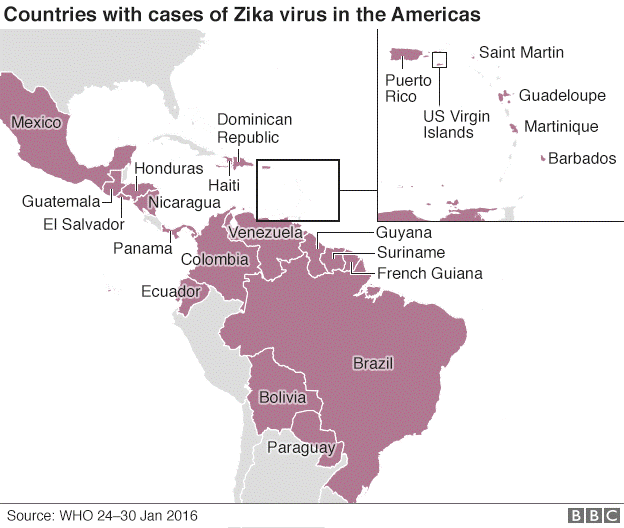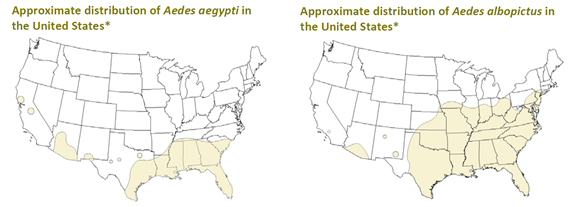Zika Virus
Recommended Traps for the Vectors of Zika Virus[1]
Background on Zika Virus in the Americas
Geographical range of Zika virus
Prior to 2015, Zika virus (ZIKV) outbreaks were confined to Africa, Southeast Asia, and the Pacific Islands. In May of 2015 the Pan American Health Organization (PAHO) issued an alert regarding the first confirmed ZIKV infections in Brazil. Currently, outbreaks are occurring in many countries in the Americas. As of 30 January 2016, ZIKV has been reported from Barbados, Bolivia, Brazil, Colombia, Dominican Republic, Ecuador, El Salvador, French Guiana, Guadeloupe, Guatemala, Guyana, Haiti, Honduras, Jamaica, Martinique, Mexico, Panama, Paraguay, Puerto Rico, Saint Martin, Suriname, U.S. Virgin Islands, and Venezuela. CDC and PAHO/WHO are forecasting that ZIKA will continue to spread in the Americas.
Importation and local transmission of Zika virus in the United States
Zika virus is a flavivirus; this genus of arboviruses includes other mosquito-borne viruses that have been reported or are endemic in the United States (West Nile, dengue virus (WNV), yellow fever virus (YFV), and St. Louis encephalitis virus (SLEV). Along with chikungunya virus (CHIKV, an alphavirus), dengue (DENV) and Zika (ZIKA) viruses are transmitted between humans in the Americas by Aedes aegypti and Aedes albopictus. As of 1 February 33 cases of travel-related ZIKA have been reported in the States. The Dallas County Department of health said (on 2 or 3 February) that the person was infected through sexual contact with someone who had traveled to Venezuela; so the first report of local transmission of ZIKA was via sex. The person infected did not travel to the South American country, county health officials said. Given the number of endemic countries in the Americas, levels of international travel, and the presence of Ae. aegypti and Ae. albopictus in the United States, local transmission of ZIKA would be considered quite likely. New local transmission of ZIKA would pattern local transmission of CHIKV and DENV following their introduction via travelers. CDC says it is expected that ZIKV transmission will increase throughout the region increasing the incidence of infection in returning travelers and the possibility of local transmission in the USA.
Modes of transmission
Regarding modes of transmission, CDC indicates that Zika virus is a single-stranded RNA virus that is transmitted to humans primarily through the bite of an infected Aedes species mosquito. The mosquito vectors typically breed in domestic water-holding containers; they are aggressive daytime biters and feed both indoors and outdoors near dwellings. Nonhuman and human primates are likely the main reservoirs of the virus, and anthroponotic (human-to-vector-to-human) transmission occurs during outbreaks.
Perinatal, in utero, and possible sexual and transfusion transmission events have also been reported. Zika virus RNA has been identified in asymptomatic blood donors during an ongoing outbreak. In 2016, Zika virus disease became a nationally notifiable condition.
Approximate distribution of Ae. aegypti and Ae. albopictus[2]
CDC recommendations regarding surveillance, prevention, and control[3]
The prevention or reduction of transmission of DENV, ZIKV, and CHIKV (there is a safe and efficacious vaccine against YFV) is completely dependent on the control of mosquito vectors and limiting person-mosquito contact. Mosquito surveillance is a key component of any local integrated vector management program. The goal of mosquito-based surveillance is to quantify human risk by determining local vector presence and abundance. The principal functions of DENV, CHIKV, and ZIKV mosquito-based surveillance programs are to:
- Determine presence or absence of aegypti and Ae. albopictus in a geographic area
- Identify what types of containers are producing the most mosquitoes for targeting vector control efforts
- Develop detailed maps to track larval sites if aegypti or Ae. albopictus are detected in an area
- Collect mosquito population data and identify geographic areas of high abundance (high-risk)
- Monitor the effectiveness of vector control efforts
- All vector control efforts can be qualitied using the adult surveillance traps listed below; some were actually designed and evaluated by CDC in Atlanta and San Juan, Puerto Rico
Arbovirus transmission ecology varies regionally and surveillance practices vary among programs (e.g., number and type of traps, frequency of sampling, etc.) based on available funding, resources, and trained staff. However, in order to quickly identify and mitigate a mosquito-borne disease outbreak, establishing and maintaining a local vector surveillance program is critical.
Whereas mosquito-based surveillance is the preferred method for monitoring or predicting West Nile virus outbreaks, it is not the preferred method for monitoring or predicting DENV, CHIKV, YFV, or ZIKV outbreaks. For these arboviruses, it is more efficient to detect cases in people. In the United States, dengue and chikungunya are both nationally notifiable conditions. Healthcare providers are therefore required to report any confirmed or suspect cases to local and state health departments. In turn, health departments should immediately notify state/local vector control districts or authorities. Timely identification and response to mosquito-borne disease outbreaks like dengue, chikungunya, yellow fever and Zika require constant communication between healthcare providers, local and state public health departments, and vector control specialists. Effective vector-based dengue, chikungunya, yellow fever and Zika prevention involves initiating control measures such as source reduction (container elimination) and larvicide treatments before the beginning of the mosquito season, and adult reduction measures such as adulticide treatments following detection of human arbovirus activity. Containment, a combination of procedures to prevent DENV, CHIKV, ZIKV and YFV from spreading, may be initiated whenever a suspected/confirmed imported or locally acquired case is detected. During outbreaks a combination of containment and large-scale vector control may be used to minimize vector-human contact.
Traps and Aspirators Made by the John W. Hock Company that are Useful and Specific for the vectors of ZIKA
Traps and aspirators manufactured by the John W. Hock Company that were designed for the ZIKA vectors Ae. aegypti and Ae. albopictus include:
Daytime traps for Aedes aegypti and Aedes albopictus
- CDC Fay-Prince Trap
- CDC Fay-Prince Blacklight (UV) Trap
- Omni-Directional Fay-Prince Trap
- CDC Wilton Trap
Carbon-dioxide-baited traps
- New Standard Miniature Light Trap with Photocell-Controlled CO2 Release
- Most traps where the catch is enhanced using dry ice in an Igloo cooler
Blacklight traps
- New Standard Miniature Blacklight (UV) Trap
- CDC Fay-Prince Blacklight (UV) Trap
- Miniature Downdraft Blacklight (UV) Trap
- CDC UpDraft Blacklight (UV) Trap
Aspirators
- Battery-Powered Aspirator
- Improved Prokopack Aspirator
- Modified CDC Backpack Aspirator
- Mouth Aspirators
[1] Much of the information here is from or based upon CDC, the WHO, PAHO, and the scientific literature. The content here is based on information available as of February 2016.
[2] Maps were developed by CDC using currently available information. Mosquito populations may be detected in areas not shaded on this map, and may not be consistently found in all shaded areas.
[3] http://www.cdc.gov/chikungunya/resources/vector-control.html

